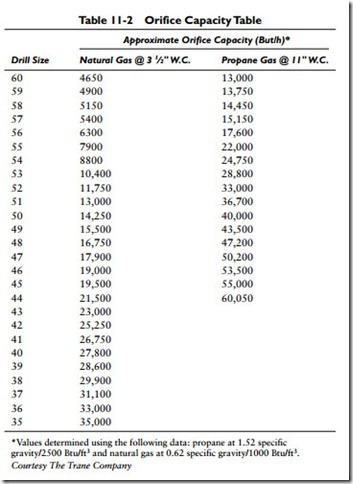High-Altitude Adjustment
For elevations above 2000 ft, the Btu input should be reduced (derated) 4 percent for each 1000 ft above sea level. This adjustment is required because of the increase in air volume at higher elevations. Air expands at approximately 4 percent per 1000 ft of elevation. At elevations above 2000 ft, the volume of air required to supply enough oxygen for complete combustion exceeds the maximum air-including ability of the burners. Because the primary air volume cannot be increased, the gas flow (input) must be decreased (that is, derated).
Changing Burner Orifices
A gas-fired furnace is supplied with standard burner orifices (spuds) for the gas shown on the rating plate. The orifice size will depend on the calorific value of the gas (Btu per cubic foot) and the manifold pressure (3.5 in W.C. for natural gas and 11 W.C. for LP gas). The burner orifice size partially determines the firing rate by allowing only a predetermined volume of gas to pass. An orifice that is too large will allow too much gas to pass through into the burner. This condition sometimes results in overheating the heat exchanger or restricting the air-inducing ability of the burner.
The gas burner orifices supplied with a furnace are suitable for average calorific values of a gas at the listed manifold pressures. Table 11-2 lists the various orifice capacities for different drill sizes. The procedure for determining the suitability of a particular drill size is as follows:
1. Divide the total Btu input of the furnace by the total number of burner orifices in the unit.
2. From Table 11-2, select the burner orifice size closest to the calculated value (plus or minus 5 percent) for the gas used.
Courtesy The Trane Company
This procedure can be illustrated by determining the most suitable drill size for a 150,000-Btu-input, gas-fired furnace. This furnace has four burners, with two orifices per burner, and uses natural gas.
In Table 11-2, the figure closest to 18,750 in the left-hand column (natural gas) is 19,000. The drill size opposite this figure is No. 46.
Related posts:
Incoming search terms:
- how to adjust propane heater for high altitude
- high alltuitude gas valve
- gas furnace replacing pressure switch high altitude
- gas furance orifice
- how to derate gas
- every 1000 feet above sea level the capacity of a natural gas furnace is de-rated by
- lp gas orifice size at high elevation
- orifice sizing for higher elevations
- dometic furnace high altitude
- nordyne natural gas furnace what size for high altitude
- orifice needed for a 30000 btu furnice
- propane furnance orifice
- propane orfice for trane furnace
- suburban water heater orifice high altitude
- do you need high altitude orface for console heaters
- how high elevation for prpane stove different orifice
- methane btu rating ar elevation
- altitude adjustment for furnaces
- #18 orifice high altitude
- gas furnaces mail
- lp orifice size difference for sea level vs high altitude
- elevation and impact on hvac performance
- number of burners for the different BTU furnaces
- different pieaces of equitment used for high altitude
- orifice size for altitude propane appliance
- high altitude portable burner
- BTU DROP GAS RANGE ALTITUDE
- adjust furnace for elevation and temperature
- what altitude do you need to change out offices on a furnace
- lp graysonline com/Hole_Drills/Equipment mail
- Engines Natural Gas mail
- high altitude burner conversion for gas stove
- HIGH ALTITUDE GAS PRESSURE RATING
- high altitude orifice
- gas elevation orifice change
- how elevation affects orifice size
- gas derate chart
- how much reduction in orifice size at altitude for gas stove
- how to adjust gas pressure at high altitude
- gas in high altitude
- how to change orifice in furnace
- gas burners mail
- what size orifice do you need for natural gas at570 feet elevation

